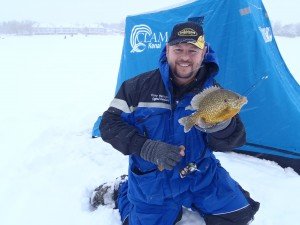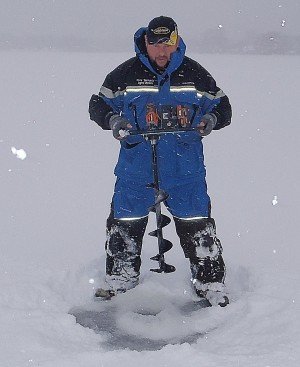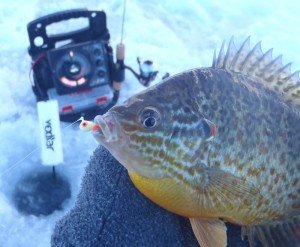 Ice fishing isn’t for everybody, but for some it holds a special place in our hearts. Some may think we are a bit crazy for walking out on a frozen pond or lake, but there is something about the sound the auger makes as it chews through the ice that keeps us coming back time and time again.
Ice fishing isn’t for everybody, but for some it holds a special place in our hearts. Some may think we are a bit crazy for walking out on a frozen pond or lake, but there is something about the sound the auger makes as it chews through the ice that keeps us coming back time and time again.
As said, ice fishing isn’t for everybody, but it (the ice) certainly is for me. Armed with a good set of spikes on my boots and a warm Ice Armor suit I find myself hitting the frozen surface more and more every year. These trips are spread out on many bodies of water and in several different states. The key to all of these trips and to catching fish is to make yourself as mobile as possible.
Often you will see groups of guys set up camp in one area and spend their day on these one or two holes with only a few fish to show for it. If you want to increase your odds of finding fish and staying on them you have to remain mobile and be able to move when the fish move.
It is not uncommon to drill 50 holes in a matter of a couple hours while looking for fish, structure, weeds, or changes in the water depth. If you are not moving and searching you may miss out on a bite that can happen in small windows of time.
You may have heard of this method referred to as “Ice Trolling”. This sums it up pretty nicely. You are moving with the fish and to find the fish. Keep moving and you are sure to keep catching fish.
 There are a few things to keep in mind when employing this technique. It is rather simple, yet too many people tend to overlook the reasoning behind this moving. Fish are not creatures that will stay in one spot very long. The fish are always moving to find food, oxygen, and cover.
There are a few things to keep in mind when employing this technique. It is rather simple, yet too many people tend to overlook the reasoning behind this moving. Fish are not creatures that will stay in one spot very long. The fish are always moving to find food, oxygen, and cover.
The fish’s major driving force for moving during this time of year would be in search of food. If you can find the food source you will also locate the fish. Structure is certainly second, however if you think about it these often tend to go hand-in-hand.
We could go into depth about the movement of fish and how they relate to different structure at different times during the day, but let’s save that for a later date. We want to focus on staying mobile and how you can go about doing this to the stay on the fish and to use it to your advantage.
Mobility is important for the ice angler and there are several important items that you can have to assist in this pursuit. You probably already have most of what you need, but the key is to be able to use it to your advantage.
Pack light would be the first word of advice when it comes to staying mobile and on the move. There is no need for extra gear like tip-ups, minnow buckets, etc if you are only targeting bluegills. Pair your gear down to the species that you are after.
Limit your rods to the species of fish you are in pursuit of. There is no need to carry every rod you have if you are only going to be needing a couple that will do the job for you. A great way to carry your rods and keep them out of harms way is in a good sturdy zippered case. I prefer to use the Ice Armor case as it has a tough denier outside and it is light enough to carry alone or in a sled.
Speaking of sleds, this is a great tool that will allow you to remain mobile, yet have a base that you can use to carry gear or even take a seat if needed. I have found that a nice one-man flip over shelter such as the Clam Scout works great for this. The shelter allows you to get out of the wind if you need to or it allows you to block out the light on those high sky days. This often can mean the difference between active and inactive feeding fish.
If you are using a sled or a small shelter, make sure you use a pulling harness or a long rope that you can put across your chest. This will allow you to use your body to pull the sled and leaves your arms free to drill holes as you move along the frozen surface.
In the lower midwest the ice does not get to the thickness that you might find in more northern states so a good hand auger is plenty to do the trick and still stay on the light side of things. Even better is a portable drill attachment and a couple spare batteries and you can drill over 100 holes without a worry.
The new Drill adapter plate from Clam Outdoors has made moving around for me much easier and I can chew through ice in seconds while trying to stay up with the fish.
Keep your auger small though. Stick with a 5” or 6” auger as the amount of work to drill is directly related to the diameter of the auger. This size is plenty large to pull up a nice slab crappie yet small enough to use little effort when making multiple holes.

One thing that every ice troller should have is a good flasher. This is an invaluable tool to help eliminate “dead” water and to allow you to locate fish and other structure. With the use of my Vexilar FLX28 it only takes a few seconds to dip the transducer into a newly drilled hole to find out if I should make a move or sit tight for a bit.
The use of electronics has grown leaps and bounds over the years and with today’s technology you can even incorporate a good gps with mapping chips to allow you to follow the contours of the lake. An even more handy way has been the introduction of the Navionics application on your smart phone. The application will allow you to plan your attack while you are on the move.
Staying mobile is easy, yet very important. Keep it light and pair your gear down. Keep drilling until you find fish and after you find them be ready to move again when they move. If you stick around too long those fish will move on. You can always backtrack as you follow the fish and hit the holes you have already drilled.
Trolling isn’t just for the open water guys. Use this approach on the ice and you are sure to find the fish you are after. Keep it simple and keep in light and you are sure to have a great time on the ice.
Cory Yarmuth
Legend Outdoors

